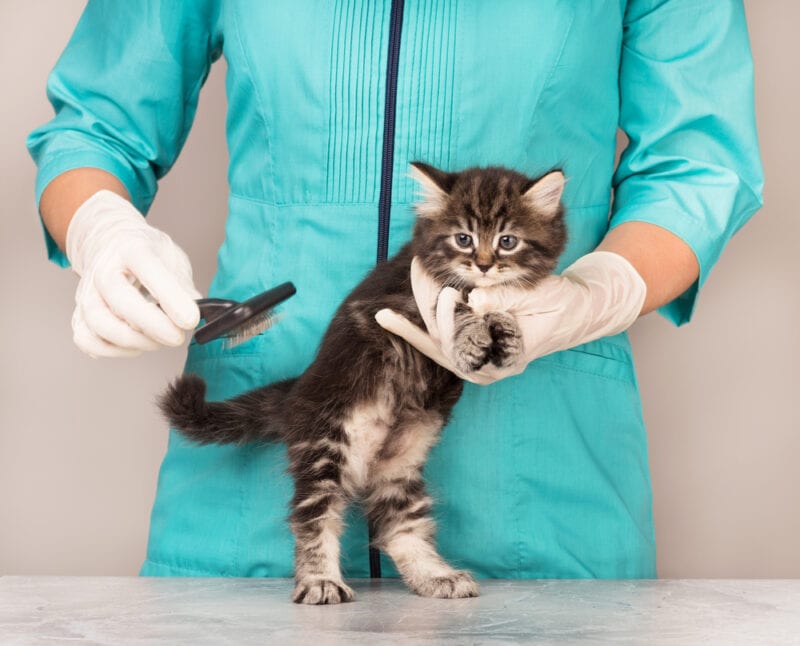
Kittens are amazing. They’re cute and curious, they’re mischievous and hyper, and they’re bundles of fun to have around! Seriously, who doesn’t love kittens?
If you’ve never had a kitten before, though, you may find that you’re not quite sure how to take care of them beyond feeding and cuddling them. As fun as they are, kittens can be a great deal of work, and there are several things to know before deciding to adopt one.
This step-by-step guide goes over how to take care of a new kitten, so you know exactly what you’re getting yourself into before you bring home a fluffy ball of joy. From nutritional needs and socialization to kitten health and more, you’ll find everything that you need here!
Step-by-Step Guide: How to Take Care of a New Kitten

Preparation
There are a few things you’ll need to do before you go and adopt a kitten.
1. Is a Cat Right for You?
Seriously consider whether a kitten is right for you and your lifestyle. Cats tend to live anywhere between 10 and 15 years, which makes them a big commitment. If you don’t have a lot of time and resources to dedicate to a new kitten, you might want to think about a pet that requires less. Other factors to consider are whether you have other pets that might not get along with a new kitten, any allergies you or your family may have, and if you have children, whether they will be able to handle a kitten appropriately.
2. Which Breed Should You Choose?
Decide what kind of kitten you want. There are about 40 different cat breeds! If you already know what breed you want, that’s excellent. If not, it’s best to do a little research to find out which ones you might be interested in. Consider your lifestyle when doing so. Are you home all day? Then you might be okay with a more energetic breed. Would you be too tired to play with a kitten when you get home from work every day? Then you might want one that’s less active.
3. Where Do You Get a Kitten?
Once you’ve found the breed you think will work best for you, it’s time to figure out where to get them. Options include a breeder, a shelter, or even online. If you’re not so picky about the kind of kitten you want, going to a shelter or adopting one online might be better (it will certainly be less expensive!). But, if you want a specific breed or a purebred, you may not find what you want at a shelter or an adoption site.
Adopting

Once you’ve decided on where to get your new pet, you’ll need to make sure you get all the info you can before adopting.
1. Prepare the Questions
When you’re ready to get the newest member of your family, you should be prepared to ask whomever you’re adopting from a few questions. Contact the workers at the shelter, breeder, etc. How did they receive the kitten? If their current owners gave up the kitten, was it because of a behavioral issue or another reason? What is the kitten’s medical history (health issues, shots already received, etc.)? What is the kitten’s personality like? Is the kitten a picky eater? Finally, ask if you might be able to spend a bit of time one-on-one with your potential kitten.
2. Verify the Kitten’s Age
Kittens should remain with their mothers (if momma cat is still in the picture) until between 12 and 14 weeks. Adopting a kitten younger than that could result in health or behavioral issues.
Before You Bring Your Kitten Home
You’ve found the kitten that’s perfect for you, and you’re almost ready to bring them home. Here’s what you need to do first.
1. Find a Good Vet
You’ll need to take your new feline buddy to the vet straight away, so now is the time to find a good one. If you picked your kitten from a shelter, ask them whom they recommend, as they will likely have one they use a lot. You can also ask your friends who are pet parents where their vet’s office is or go online and read reviews for vets in your area.
2. Kitten-Proof Your Home
Your new kitten will get into everything—literally. Block off any way your kitten might be able to escape your home, such as windows or vents. Put away items your kitten might like to sink their teeth into, such as power cords or plants (some plant species can be toxic to felines). Put away any items you love that could be shredded by tiny claws.
3. Get All the Items Your New Kitten Will Need
Your kitten is going to need a variety of things to keep them happy and healthy. This list includes a litter box they can easily get in and out of, litter, food, food and water bowls, collar and tags, cat carrier, brush or comb, toothbrush and toothpaste, and plenty of toys and scratching posts.
Know the Right Food for Your Kitten
Your kitty should be well-fed, but there’s more to it than how many times a day you feed them. Your kitten will have specific nutritional needs that must be met for them to grow up to be strong and healthy.
1. Know That Kittens Need a Special Diet
Understand that your kitten has different nutritional needs than those of a full-grown cat. Your kitten will be growing fast—particularly in the first few weeks—and they will have way more energy than an adult cat. So, while some aspects of their nutritional needs will remain the same throughout their life, when it comes to amino acids, minerals, and proteins, they will require more than an adult cat. Your kitten will also need more protein and calcium. When it comes to protein, they should be getting between 30% and 40% of their nutrition from it.
2. Pick Wet or Dry Food
There are upsides and downsides to both wet and dry foods. Wet food has a higher water content, which aids your kitten in staying hydrated. However, it can also stick to your kitty’s teeth, causing dental problems down the road. Dry food, depending on the type, may help when it comes to dental health by scraping off tartar. Plus, if you have a multi-cat household, dry food is easier to deal with at feeding time. That said, it’s also easier to overeat, which can cause weight gain that in turn, leads to health issues.

3. Know How Often to Feed a Kitten
Know how many times a day to feed your kitten. Until they’re approximately 6 months of age, your kitten will likely need to be fed three times a day. After that, it should be fine to drop to two feedings a day.
4. Determine Which Brand of Food to Choose
Research brands of pet food to see what is the best fit for your kitten. Pet food brands are not all created equal, so you want to be sure you’re feeding your kitten the healthiest food you can. You don’t want to pick a food with a lot of fillers, as it should be something with high-quality ingredients. Compare labels among brands, or ask your vet what their recommendation is. Also, check to see which brands carry a statement from the Association of Animal Feed Control Officials (AAFCO), which ensures that minimum standards in pet foods have been met.
Your Kitten Is at Home! Now What?
Now that your new little one has finally arrived, where do you begin?
1. Take Your Kitten to the Vet

You should take your kitten for a check-up within the first couple of weeks of their arrival. Your new feline friend might have had a few shots before you adopted them, but kittens receive vaccines up to the age of 4 months, so they likely will not have had them all. Your vet will also need to test for worms and start them on medication to ward off fleas when they’re old enough. This is also a great time to have a conversation about when your pet should be spayed or neutered if they aren’t already. Your vet can also advise you of signs to look for that could indicate ill health.
2. Train Your Kitten to Use the Litter Box
Kittens should start being introduced to the litter box around 4 weeks old, so your new kitten should know how to use it, but there are always exceptions. Plus, being in a new home, they’ll need to figure out where everything is. Start with making sure your litter box is one a kitten can get into (low sides or one that isn’t covered). Next, be sure it’s in a place your pet can easily get to and in an area with few things to distract them from the task at hand. If you have more than one floor in your home, place a box on each floor.
Once you’ve placed your box (or boxes), it’s time to introduce the kitty! Bring them to each box, and let them give it a good sniff. Once they’ve done that, place the kitten in the box. They may not use the box at this point—if not, put them in it after each feeding till they get the hang of things. Finally, keep the litter box extra clean during training. If you can’t get your kitten to use the box, you can try a different type of box or litter or clean the box more often, and if all else fails, take your kitten to the vet to make sure everything is okay.
3. Keep an Eye on Your Kitten’s Poop

While cats can come down with stomach ailments at any age, intestinal parasites and bacterial and viral infections are more common in kittens. Checking your pet’s litter box after they use it is a useful way to catch any issues early. Kitten poop should be well-formed and brown; other colors and textures could indicate trouble.
4. Keep Your Kitten in a Single Room
The first few days in your home, keep your kitten in a single room, then slowly let them into the rest of your home. This will make them feel safer as they get used to all the newness surrounding them.
5. Start Socializing Your Kitten Early

Play with and pet your kitten often to establish a bond between the two of you. Then, slowly begin introducing your new pet to other people (and pets). Always keep an eye on children and kittens to make sure things are going well. Now is also the time to start teaching them how to ride in a pet carrier, wear a collar, and sit for grooming. Your kitten may be scared of a few things, but with a bit of reassurance, they’ll quickly adapt to all the new stimuli!
6. Play With Your Kitten for Around 40 minutes a Day
Kittens need to be mentally stimulated so they don’t get bored and start behaving badly, which means you should use different types of play. Engage your pet with the all-time kitty-favorite laser pointer, toss around small balls they can run after, get a toy that dangles from a stick so they can jump around, or stimulate them with puzzle feeders when it comes to treats. Do not, however, let them play with your hands and feet, as that will teach them that parts of the body are toys—a behavior that’s much less cute in adulthood than kittenhood.
7. Groom Your Kitten

Cats are known for their fastidiousness, so for the most part, your kitten will take care of their own grooming. There are a few things you can do to help them out, though. To save yourself and your furniture from any scratches and to keep your pet’s nails healthy, you’ll want to start regularly clipping their nails when they are old enough. You can do this yourself if you’re feeling brave or have your vet do it.
Brushing your kitten a couple of times a week will help remove dead hair, flaky skin, and dirt. Brushing your kitten’s teeth once a day is ideal but not always realistic. If you can’t do it each day, once a week should suffice. Grooming your kitten should start sooner rather than later so they can get used to it. If you have any issues with grooming, your vet should be more than happy to demonstrate the best way to do something.
Final Thoughts
Taking care of a kitten requires a great deal of work, but the rewards are more than worth it. Once you’ve chosen your kitten, acquired the needed supplies, found a good vet, and made your home kitten ready, all that’s left is the work of raising your kitten—and that’s the fun part! With this step-by-step guide, you’ll be able to nurture and handle your new pet like a pro when you finally adopt.
Related Reads:
Featured Image Credit: Lubava, Shutterstock







